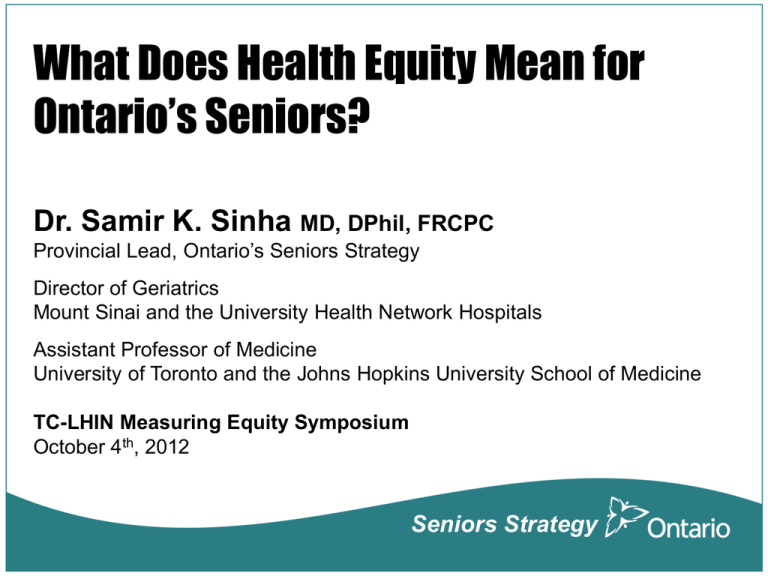Seniors Strategy - Mount Sinai Hospital
advertisement

What Does Health Equity Mean for Ontario’s Seniors? Dr. Samir K. Sinha MD, DPhil, FRCPC Provincial Lead, Ontario’s Seniors Strategy Director of Geriatrics Mount Sinai and the University Health Network Hospitals Assistant Professor of Medicine University of Toronto and the Johns Hopkins University School of Medicine TC-LHIN Measuring Equity Symposium October 4th, 2012 Seniors Strategy Establishing the Context 14.6% of Ontarians are 65 and older, yet account for nearly half of all health and social care spending (Census, 2011). Ontario’s older population is set to double over the next twenty years, while its 85 and older population is set to quadruple (Sinha, HealthcarePapers 2011). Ontario’s ageing population represents both a challenge and an opportunity. Seniors Strategy Diversity in Ontario’s Seniors Ontario’s visible minority population stands at 23%, the second highest after British Columbia (24%). A higher share of seniors in visible minority groups live in low-income households. Seniors are most likely to say they cannot converse in English or French. Beyond our ethnocultural and linguistic differences, our diversity as Ontarians is also reflected through gender identity and sexual orientation. Seniors Strategy Diversity in Ontario’s Seniors About 5% of seniors in the province arrived in the last 20 years, this proportion will increase. As a collective group, immigrants are older – one in five is a senior. Immigrants comprise 41% of Toronto’s population. Currently 400,000 to 500,000 people in the Greater Toronto Area have limited English ability and require interpretation support in a medical setting. Seniors Strategy Meet Mr. W Why Develop a Provincial Strategy? Given our current and future challenges Ontario’s Action Plan for Health Care was launched in January, 2012 with a focus on quality, access, equity, value and choice. The Development of a Seniors Strategy was highlighted as a way to establish sustainable best practices and policies at a provincial level that could support the overall coordination of the delivery of health and social care services with an intense focus on supporting seniors to stay healthy and stay at home longer. Seniors Strategy Key Strategic Themes/Areas of Focus Promotes Wellness and Prevention Ensures Better Equity, Access, Quality, Value and Choice Leverages Existing Infrastructure and Resources, while Reducing the Duplication of Processes and Services Improves Coordination and Integration of Care in the Community that Meaningfully impacts ED, Hospital and LTC Utilization. Aligns Incentives Within and Across Sectors with Common Metrics and Accountability Frameworks Sets Minimum Standards of Care across All Sectors Explores housing and transportation services to meet specific needs Includes Mental Health and Palliative Care Seniors Strategy When Strategy Meets Diversity… Services in one’s language of choice? ie. 211, Language Services Toronto Services geared to ethnocultural needs? ie. Ethnocultural Facilities, Day Programs, Meals on Wheels Service providers and experiences that are culturally competent and aware? ie. Services for Aboriginals, LGBTQ Populations Are we being realistic with our expectations and abilities to serve older Ontarians with diverse needs? What can’t forget to address the Determinants of Health… Seniors Strategy What Does Excellent Care for All Seniors Look Like? SHARED ACCOUNTABILITIES – SHARED CORE METRICS – ALIGNED PERFORMANCE TARGETS Promoting Wellness -Single point of access to information to empower and support self-management -Wellness and prevention programs will reduce deconditioning, improve functional capacity, independence and older adults ability to stay home longer: Supporting Aging in Place Senior Friendly Hospital Care and Effective Transitions Enhanced Long-Term Care Environments -Strengthened Primary Care models will improve access and provide home-based care options. -When hospital care is required, seniors will benefit from an elder friendly environment and culture emphasizing early screening and assessment by GEM Nurses, functional support and timely discharge home/community and the prevention of ALC. -Improving the capacity of the long-term care sector to support more short-stay and restorative care options and discharge back to the community -Enhanced CCAC and CSS Services and linkages to Primary Care. -Leverage Elderly Persons Centres to help strengthen social networks and provide access to wellness and prevention and care services. -Improve access to community-based therapy services that optimize functional capacity and independence -Promote screening and early linkage to the appropriate support services -Telehomecare, NLOTs and Geriatric Services. -Seamless and Safe discharges facilitated by Rapid Response Nurses emphasizing a connection to the primary care provider within 7 days of discharge. -Specialized services for residents with challenging and complex behaviours -Quality long-term care for residents who require it -Reduced ED/hospital transfers through enhanced NLOT services. Timelines Ontario’s Action Plan for Health Care – January 30, 2012 Seniors Care Strategy Lead Announced – May 24, 2012 Stakeholder Consultations – Summer 2012 Presentation of the Strategy and Implementation Plan to the Minister of Health and Long-Term Care – Fall 2012 Once Approved, the Seniors Care Strategy Lead will work with the health care sector to implement the strategy. Seniors Strategy This is Ontario’s Time to Lead Questions? Samir K. Sinha MD, DPhil, FRCPC Provincial Lead Ontario’s Seniors Strategy samir.sinha@ontario.ca Seniors Strategy






